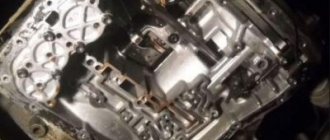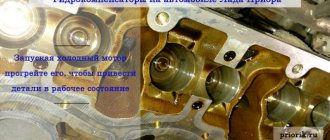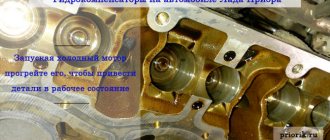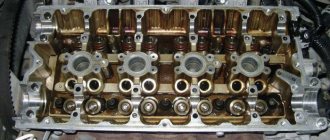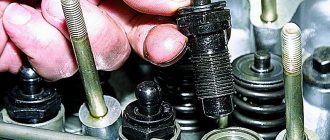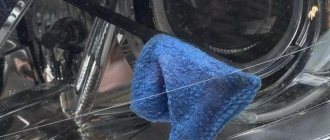Increased engine noise may indicate the presence of serious malfunctions, which can lead to complete inoperability of the unit.
The knocking of hydraulic compensators when cold does not belong to this category, but if this part is not adjusted, the engine will consume more fuel, develop less power and the comfort of driving the car will sharply decrease. The wear of the piston group will also increase due to incorrectly selected gaps in the gas distribution system.
This article will tell you in detail how to eliminate the knocking of hydraulic compensators, as well as how to do this work efficiently and with minimal time and financial costs.
Knocking of hydraulic compensators: reasons
To understand how to get rid of the knocking of hydraulic compensators, you need to have a good understanding of the operating principle of these parts. The thermal expansion of the metal as a result of heating was the reason for the invention of this type of mechanism.
In old-style cars, instead of hydraulic compensators, adjusting bolts were installed, with the help of which the thermal gap was manually adjusted. This method of eliminating increased gaps in the gas distribution system required the car owner to spend a significant amount of time and money, because the need for manual adjustment arose every time the car traveled 10 - 15 thousand km.
In modern cars this function is fully automated using small inserts between the rocker arms and the valve stem. The operating principle of this part is quite simple:
- Oil from the lubrication system enters the cylindrical cone of the compensator under pressure when the camshaft cam does not apply pressure. Inside the part there is a plunger pair, with the help of which the filling of the internal cavity with oil is regulated until the moment when the pressure part of the mechanism extends to a distance that completely compensates for the existing gap between the part and the valve stem.
- At the moment when the camshaft rotates to the angle required to start applying pressure to the valve, the oil supply is shut off and, taking into account the fact that oil is a practically incompressible liquid, the compensator maintains the required length and transmits the force from the camshaft to the valve stem without delay.
- After the valve returns to the closed position, the entire cycle of operation of the hydraulic compensator is repeated again.
Click on the picture to enlarge
Considering the fact that the internal volume filled with oil can vary depending on the size of the gap, it is possible to completely avoid delays in valve opening and, as a result, increased noise of the gas distribution mechanism.
Unfortunately, hydraulic compensators, like any car part, can fail. A malfunction of this part will inevitably lead to the formation of a characteristic knocking sound during engine operation. Most often, hydraulic compensator noise is caused by the following reasons:
- Wear.
- Manufacturing defects.
- Internal valve jammed.
- Air in the internal cavity of the part.
- Valve mechanism clogged.
All parts of the car are subject to wear, including hydraulic compensators. Therefore, if the car is many years old, it may require a complete replacement of all elements.
Factory defects are not common, but such a malfunction occurs in the first months of car operation. If this reason for the inoperability of hydraulic compensators is identified, repairs are usually carried out at the expense of the manufacturer.
Jamming of the internal valve can occur if low-quality oil is used or non-certified parts have been installed. This malfunction can be eliminated by replacing parts or cleaning them.
Air can enter the internal cavity of the hydraulic compensator if the oil level in the engine crankcase is too low. Also, such a nuisance can await the driver if the oil line through which the oil is supplied is clogged with various deposits.
If the hydraulics are knocking, then it is not necessary to contact specialized workshops to eliminate the problem. You can completely get rid of the noise of hydraulic compensators yourself, if you have minimal knowledge and skills in repairing and servicing internal combustion engines.
Once the causes and consequences of the noise are clear, you can begin to troubleshoot the problem.
Methods for eliminating increased noise of hydraulic compensators
There are several effective ways to eliminate the knocking of hydraulic compensators. One of the most budget-friendly options is to clean these parts.
To perform this operation you must:
- Remove the engine valve cover.
- Remove the rocker arm axles.
- Remove the hydraulic compensators.
- Clean the outside of the parts with a non-natural bristle brush.
- Place each part one by one in a container with kerosene and press the ball valve and plunger several times with a wire.
- At the next stage, the hydraulic compensators are placed in a second container with clean kerosene, after completely removing the liquid remaining from the previous flushing.
- At the third stage, it is necessary to check the performance of the hydraulic compensators by adding flushing fluid to them. After which the part is held in a vertical position, with the plunger facing upward. If you press the plunger with your finger, it should not move, and no flushing liquid should be released from the internal cavity of the hydraulic compensator.
About the design of gas distribution mechanisms
In a simple case, the compensator is an extension of the valve heel. More precisely, the hydraulic compensator is mounted on the valve and transmits the force received from the cam. This diagram is clearly shown in the figure:
Here the compensator comes into contact with the cam
What is considered is one of the options. But there is another one, when the cam presses on the rocker arm. The rocker itself is pushed up by two different elements. On one side it will be a valve, on the other - a hydraulic compensator. The first of them moves, the second remains at the same level:
The compensator presses on the rocker from below
If the compensator is faulty, a gap will appear between the cam and the rocker arm.
Note that the lever rocker arm of the valve was not discussed above. The diagram with a lever rocker is shown below. The compensator looks different there than in cases “1” and “2”.
Previously, the timing design used a single camshaft (SOHC), and the force to the valve heels was transmitted through a lever. In order to eliminate the gap, the lever was equipped with an adjusting screw 5. It was fixed with a lock nut 6:
Timing diagram with lever rocker arms
The mechanism discussed above can be equipped with hydraulic compensators. Their device is shown in Figure “b”:
Schemes “a” and “c” correspond to the first and second cases. There shouldn't be any questions here.
Externally, the design of compensators may vary, but the principle of operation will always be the same. The main design elements are the following parts: check valve (ball), plunger spring 5 and valve spring 6. Number 3 indicates the plunger sleeve, and part 2 is the plunger.
Note that hydraulic compensators are not used in the design of the 4A-FE and 5A-FE (Toyota) engines. They are available in motors of the following series: 2S, 1NR, ZR, TR, 5M.
Hydraulic compensators: what are they and where are they located?
These elements are an important part of the gas distribution mechanism. These hydraulic compensators can be found directly above the valve. To be more precise, under the camshaft cam.
This part looks like a cylinder. Inside it there is a special check valve, a plunger pair, and a spring. Special channels are made in the walls of the hydraulic compensator. They serve to circulate oil.
Function of hydraulic compensators in the engine
During operation of a car engine, every part of it heats up to high temperatures. The valves are also subject to heat. If you remember the physics course, then at the moment of heating the body expands. This means that the gaps between the valves and rocker arms in the valve mechanism will inevitably decrease.
On older car models with simpler engine designs, valve clearances were adjusted manually. This is not a difficult job, but it requires certain skills, knowledge and a set of tools to complete it. If the gaps are adjusted incorrectly or at the wrong time, certain problems will arise. One of them is a knock, which is familiar to every owner of such a car. This noise indicates that the gaps are too large.
Small gaps also led to certain problems. Because of this, the valve did not close tightly. It was necessary to adjust the mechanisms quite often, since during the operation of the motor the settings were constantly lost.
Thanks to the introduction of hydraulic compensators, the car owner no longer needs to adjust valve clearances. Now this is done automatically. In other words, the presence of hydraulic compensators in the engine design significantly simplifies the engine maintenance process, increases the life of the valve mechanism, and provides the engine with more elastic and stable operation.
Types of parts
Hydraulic compensators are widely used in timing systems, but their analogues are also used in tensioning chains. There are currently four main part designs known:
- hydraulic pusher. It is most often installed on modern car models. The device helps regulate the size of the hole between the valve and the camshaft;
- hydraulic support;
- hydraulic support for the lever and rocker arm. Most often, such parts were used on old timing mechanisms;
- hydraulic pusher on rollers.
All four of these models can be installed on different, different designs. Hydraulic mounts are more suitable for engines of older cars. Currently, more and more manufacturers are beginning to use hydraulic pushers in their designs. It is important to understand the specifics of their work.
Wrong choice of oil
Noises on a cold engine can occur for trivial reasons - the engine is filled with oil of higher viscosity. Sometimes it does not meet the manufacturer’s requirements or has expired.
When buying a car secondhand, it is recommended to immediately change the oil to a new one. Also, before replacing, you need to flush the inside of the engine. This can be done simply with your own hands in a garage. Experts recommend using semi-synthetic fluids. If the oil has been changed, but the knocking of the hydraulic compensator when cold is still heard, it is worth considering other reasons.
The knocking noise of the engine does not go away or appears after warming up
Much more dangerous is the knocking of hydraulic compensators, which appears as it warms up or only intensifies as the power unit reaches operating temperatures. In this case, the hydraulic compensators constantly knock at idle speed of a warm engine; the knock may be present under load, etc. The list of causes for this malfunction is wider than knocking noises on a cold internal combustion engine.
First, you need to make sure that it is the hydraulic compensators that are knocking when hot, since there are many reasons for knocking in the engine. To do this, you need to know how to identify a knocking hydraulic compensator. It is also important to be able to determine which hydraulic compensator is knocking, which will help more accurately localize the fault.
Note that the knocking of compensators has a characteristic sound. The pitch is high, the knock is loud, reminiscent of a metal ball striking another metal part, and is localized under the valve cover. Can be easily heard with a stethoscope. If the main valve knocks constantly, then it may soon become completely jammed or other breakdowns will occur. In such a situation, the engine needs repair; it is possible to replace the hydraulic compensators. In some cases, the seat of the hydraulic compensator is also broken. After the motor heats up, thermal expansion of the parts occurs, and the hydraulic fluid begins to “dangle” at the installation site and knock. A more accurate determination of a knocking main engine is possible after partially disassembling the motor and removing the cover.
As already mentioned, on a cold engine, contamination of the channels can cause knocking, after which the extraneous sound disappears as it warms up. In the case of a hot internal combustion engine, exactly the opposite happens, when, parallel to the increase in temperature, the deposits in the channel soften and shift, completely blocking the supply of lubricant to the main fluid chamber. In this case, it is also recommended to flush the hydraulic compensators and lubrication system, change the engine oil, or clean the engine after disassembling it.
The oil filter should be checked, which may be the cause of insufficient pressure in the lubrication system and, as a result, knocking of the engine when hot. If there is insufficient pressure in the hydraulic compensators, an air lock is created. The oil level in the engine also deserves special attention, which should not be lower or higher than normal (oil overflow into the engine). It should be noted that when cold, at low speeds and problems with the oil level, the HA may not knock. After the engine warms up, the amount of air in the oil increases and a knocking sound from the hydraulic compensators appears, as the oil and air become a compressible mixture. It is also advisable to check the operation of the oil pump and measure the pressure in the lubrication system if problems with the hydraulic fluid appear on a hot engine.
How to check the performance of hydraulic compensators
How to check hydraulic compensators on a VAZ? By removing the valve cover, you can gain access to these elements. Next, press on each of them with a finger. If a part fails, it will be recessed without effort.
In this situation, it will no longer be possible to restore the element. Only replacement will help. How much it costs to replace hydraulic lifters depends on the car model and engine. So, for most VAZ models this operation will cost five thousand rubles. If imported spare parts are selected, then the price will be 7-10 thousand. Naturally, this is not an exact cost - specific figures depend on the region and make of the car. If the mechanism is recessed only from serious force, then flushing the hydraulic compensators will help restore functionality and eliminate the knocking.
Assembly nuances
After replacing 16 hydraulic compensators, everything must be restored to its original form. The most important operations in order:
- We clean and degrease the camshafts and seats of the bed and valve cover, both on the parts and on the engine.
- We change the seals, plugs and put both shafts in place. The inlet has a special belt, which is not present on the outlet. This is its distinctive feature.
- Apply Gasket sealant to the mounting location of the camshaft bed and mount it (no gasket required).
- We treat the fit for the valve cover with sealant and mount it (no gasket required).
- We install injectors, condenser tubes, mount the manifold, generator, its belt, pulleys and timing belt.
- We restore the operation of the throttle valve, filter and connect all the wires.
Replacing hydraulic lifters sometimes results in the engine not starting due to lack of compression. As a rule, hydraulic valves are installed oil-filled and it may happen that due to the incompressibility of compensators, some valves will be open. To avoid this, it is necessary to tighten them with a clamp before installation.
Preparing for washing
So, if there is a knocking sound, but the hydraulic fluids are in good working order, then you should wash them. To do this, remove the air filter and cylinder block cover. The rocker arm axles, where the hydraulic compensators are located, are also dismantled. They are carefully removed from their seats. Before washing, prepare three containers, which together have a volume of about five liters.
Before washing, you should let the car sit in the garage for a day. During this time, the oil will drain from the hydraulic fluid into the pan. Flushing hydraulic compensators will be successful and effective if done indoors, where there is no dust and wind. Kerosene or A-92 gasoline can be used as a flushing liquid. But you can also use specialized products.
Instructions, procedure
After dismantling the expansion joints, they are cleaned from the outside with brushes with artificial bristles. Then the parts are washed in the first container, which has previously been filled with liquid for washing hydraulic compensators. Each element is lowered into the container and the check ball valve is pressed several times with a wire. Then press on the plunger.
If the stroke of the plunger becomes easy, then the compensator is washed in a second container. However, before this, all liquid is drained from the compensator. To do this, just squeeze the ball. The oil circulation channels are washed using a syringe.
An important point in performing this operation is checking the mechanisms. So, by lowering the compensator into the third container with a cleaning agent, liquid is drawn into the part.
Then the part is lowered and pulled out so that the plunger faces up. If you press your finger on it, it will not move. When everything is exactly like this, the parts are returned to their place and the engine is assembled.
Using this simple procedure, you can restore the hydraulic compensators to their functionality. Even an expensive Liqui Moly hydraulic compensator flushing additive will be no more expensive than replacing these elements with new ones.
How to wash hydraulic compensators without removing them
For those who are too lazy to remove the main body, you can wash it without dismantling it. So, to do this, the intake manifold is dismantled. Then take any decoking liquid and pour it into each of the cylinders. Next, the engine is turned with the starter. Then remove the cover and douse the compensators with carburetor cleaning agent. It is better to choose a good and expensive liquid. Then they leave the car untouched for a couple of hours.
Then everything is assembled in reverse order. When starting the engine, it is recommended to press the gas to the floor. Smoke will come out of the exhaust pipe and various debris will fly out. They gain high speed and hold it until smoke stops coming out of the exhaust pipe. It is recommended to drive at high speeds for some time. This type of washing of hydraulic compensators without disassembly is very widely used by car owners. However, it is not as effective as with removal.
Consequences
Incorrect operation of hydraulic pushers can lead to the following problems:
- reduction in compression and engine power;
- deterioration of its launch;
- burnout of valve plates and seats;
- an increase in shock load on vehicle components and parts, which will lead to their rapid failure;
- increase in fuel consumption.
If the knocking of the hydraulic pushers disappears a few seconds after starting the engine, then in this case there is no need to talk about a malfunction of the mechanism.
Additives and liquids for washing HA
According to most experienced car enthusiasts, only A92 gasoline should be used as the best cleaning agent. Kerosene will also work. Along with these folk remedies, famous manufacturers of auto chemicals offer branded liquids and additives. It must be said that most of these products are ineffective. But many people use them because they know well how much it costs to replace hydraulic compensators. There is a lot of information about a product from Liqui Moly to reduce the knock of hydraulic lifters.
Knocking after replacement
Usually new parts don't knock.
If you still hear sounds, then this is a manufacturing defect or a problem with the valves. In order to perform an accurate diagnosis and make sure that there is nothing wrong with the valves, it is necessary to check their fastenings. There is a possibility that the parts did not shrink as required. We simply tighten them and thereby remove the knock of the hydraulic compensator.
